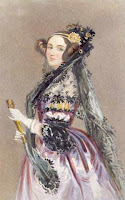"Who was Ada?
Ada Lovelace was one of the world's first computer programmers, and one of the first people to see computers as more than just a machine for doing sums. She wrote programmes for Charles Babbage's Analytical Engine, a general-purpose computing machine, despite the fact that it was never built. She also wrote the very first description of a computer and of software." - BoingBoing
OTHER NOTABLE WOMEN IN TECHNOLOGY
* Dr. Gertrude Elion patented the leukemia-fighting drug 6-mercaptopurine in 1954. Her research led to the development of Imuran, a drug that aids the body in accepting transplanted organs, Zovirax, a drug used to fight herpes, and her name is attached to some 45 patents.
In 1988, she was awarded the Nobel Prize in Medicine [. . .] Dr. Gertrude Elion was inducted into the National Inventors Hall of Fame in 1991, she continued to be an advocate for medical and scientific advancement until her death in February of 1999.
* Edith Flanigen is one of the most inventive chemists of all time [. . .] In 1956, she began to work on the emerging technology of "molecular sieves," crystalline structures that contain molecule-sized pores. The compounds with their tiny pore sizes can be used to filter and break down crude oil during the refining process.
[. . .] Her molecular sieves have made gasoline production more efficient, cleaner, and safer worldwide. Edith Flanigen's more recent work on alumino-phosphates has applications for lubricating oils.
* Silver Screen superstar Hedy Lamarr [. . .] invented a secret communication system in an effort to help the allies defeat the Germans in World War II. The invention, patented in 1941, manipulated radio frequencies between transmission and reception to develop an unbreakable code so that top-secret messages could not be intercepted. The technology called spread spectrum, now takes on many forms. However, all the spread spectrum that we use today directly or indirectly, flows from the invention created by Hedy Lamarr.

In 1988, she was awarded the Nobel Prize in Medicine [. . .] Dr. Gertrude Elion was inducted into the National Inventors Hall of Fame in 1991, she continued to be an advocate for medical and scientific advancement until her death in February of 1999.
* Edith Flanigen is one of the most inventive chemists of all time [. . .] In 1956, she began to work on the emerging technology of "molecular sieves," crystalline structures that contain molecule-sized pores. The compounds with their tiny pore sizes can be used to filter and break down crude oil during the refining process.
[. . .] Her molecular sieves have made gasoline production more efficient, cleaner, and safer worldwide. Edith Flanigen's more recent work on alumino-phosphates has applications for lubricating oils.
* Silver Screen superstar Hedy Lamarr [. . .] invented a secret communication system in an effort to help the allies defeat the Germans in World War II. The invention, patented in 1941, manipulated radio frequencies between transmission and reception to develop an unbreakable code so that top-secret messages could not be intercepted. The technology called spread spectrum, now takes on many forms. However, all the spread spectrum that we use today directly or indirectly, flows from the invention created by Hedy Lamarr.

OTHER RESOURCES:


No comments:
Post a Comment